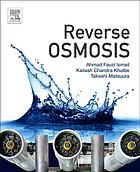Table Of ContentReverse Osmosis
Reverse Osmosis
Ahmad Fauzi Ismail
Kailash Chandra Khulbe
Takeshi Matsuura
Elsevier
Radarweg29,POBox211,1000AEAmsterdam,Netherlands
TheBoulevard,LangfordLane,Kidlington,OxfordOX51GB,UnitedKingdom
50HampshireStreet,5thFloor,Cambridge,MA02139,UnitedStates
#2019ElsevierInc.Allrightsreserved.
Nopartofthispublicationmaybereproducedortransmittedinanyformorbyanymeans,electronicormechanical,includingphotocopying,
recording,oranyinformationstorageandretrievalsystem,withoutpermissioninwritingfromthepublisher.Detailsonhowtoseek
permission,furtherinformationaboutthePublisher’spermissionspoliciesandourarrangementswithorganizationssuchasthe
CopyrightClearanceCenterandtheCopyrightLicensingAgency,canbefoundatourwebsite:www.elsevier.com/permissions.
ThisbookandtheindividualcontributionscontainedinitareprotectedundercopyrightbythePublisher(otherthanasmaybe
notedherein).
Notices
Knowledgeandbestpracticeinthisfieldareconstantlychanging.Asnewresearchandexperiencebroadenourunderstanding,
changesinresearchmethods,professionalpractices,ormedicaltreatmentmaybecomenecessary.
Practitionersandresearchersmustalwaysrelyontheirownexperienceandknowledgeinevaluatingandusinganyinformation,
methods,compounds,orexperimentsdescribedherein.Inusingsuchinformationormethodstheyshouldbemindfuloftheirown
safetyandthesafetyofothers,includingpartiesforwhomtheyhaveaprofessionalresponsibility.
Tothefullestextentofthelaw,neitherthePublishernortheauthors,contributors,oreditors,assumeanyliabilityforanyinjury
and/ordamagetopersonsorpropertyasamatterofproductsliability,negligenceorotherwise,orfromanyuseoroperationofany
methods,products,instructions,orideascontainedinthematerialherein.
LibraryofCongressCataloging-in-PublicationData
AcatalogrecordforthisbookisavailablefromtheLibraryofCongress
BritishLibraryCataloguing-in-PublicationData
AcataloguerecordforthisbookisavailablefromtheBritishLibrary
ISBN:978-0-12-811468-1
ForinformationonallElsevierpublicationsvisitour
websiteathttps://www.elsevier.com/books-and-journals
Publisher:SusanDennis
AcquisitionEditor:AnitaKoch
EditorialProjectManager:PeterJardim
ProductionProjectManager:PremKumarKaliamoorthi
CoverDesigner:ChristianBilbow
TypesetbySPiGlobal,India
Preface
Sincethefirstcelluloseacetatemembraneforseawaterdesalinationwasannouncedmorethan
halfacenturyhaspassed.Eventhoughreverseosmosis(RO)isconsideredasawell-established
separationprocess,ROisstillcontinuingitssteadygrowthbothinthecommercialmarketandas
apopularresearchtopic.Forexample,accordingtotheMembraneTechnology2011prediction
[MembraneTechnology(2011)volume2011,page7],theannualsalesofROwillgrowtoabout
40billiondollarby2020,duetoincreasingdemandforcleanandprocessedwaterandmanda-
torygovernmentregulation.Remarkableprogresshasalsobeenmadeintheareaofmembrane
preparationandcharacterization.
ThisbookwaswrittenasacomprehensivereviewofprogressinallaspectsofRO.Itshouldbe
emphasizedthatthebookhasnotbeenwrittenasanintroductiontoRO.Readersareexpectedto
haveasufficientamountofbackgroundknowledgeonROandalltherelatedsubjects.Forthis
reason,therecentprogressineachchapterissummarizedintableswiththoroughdescriptionof
onlyafewexamples.
Chapter 1 is reproduction of one of the latest articles published in Desalination. The central
themeofthechapteristhemembrane“pore”aroundwhichtheprogressduringthepast50years
hasbeenrevolving,irrespectiveofwhethertheresearcheris“for”or“against”thepresenceof
poresatthetopdenselayeroftheROmembrane.Thearticlestartsfromthe1950swhenthe
development of cellulose acetate membrane was launched on the basis of the preferential
sorption-capillary flow (PS-CF) mechanism, which later went into direct confrontation with
the sorption-diffusion (S-D) model in which pores are considered as imperfection of the
membrane. It is further shown in this chapter how the advanced characterization instrument
has revealed the heterogeneous structure of the top surface of the RO membrane and begun
to measure its “pore size” and “pore size distribution.” The advanced transport theory based
onmoleculardynamics(MD)simulationalsorevealedthepresenceofthemultimodalporesize
distribution.
In Chapter 2, it is told that many cellulosic materials were fabricated by the phase inversion
techniqueandtestedfortheirROperformancesintheearlystageofROmembranedevelop-
ment.Butthecelluloseacetatemembranewaseventuallyreplacedbythethin-filmcomposite
(TFC)polyamidemembranefabricatedbyinsitupolymerization.Thus,TFCmembranedevel-
oped by Cadotte in the 1980s is now dominating in the commercial market. Many research
papershavebeenpublishedtoimproveTFCmembranesbychangingthemonomercombination
forinsitupolymerization.SurfacemodificationoftheTFCmembranehasalsobeenattempted
toenhancetheROperformanceandtomitigatemembranefouling.ThelatestprogressinRO
membranefabricationwasmadebythedevelopmentofnanocompositemembranes(NCMs)in
which hydrophilic nanoparticles are incorporated in the TFC membrane to enhance both
ix
x Preface
membrane performance (flux and selectivity) and fouling resistance. The report on the long-
awaitedinorganicROmembranesstillrarelyappearsintheliterature.
Chapter3isformembranecharacterization.Thisistheareawherethefastestprogresshasbeen
observedbytheuseofadvancedcharacterizationtechniques.Thepricesofthecharacterization
equipmentarereasonablenowadaysandthecharacterizationfacilityisavailableinmanylab-
oratoriesworldwide.Currently,characterizationbySEM,TEM,AFM,XPS,EDX,FTIR,DSC,
TGA,andbythemeasurementof contactangleandzetapotentialisroutinelaboratoryexer-
cises.Thepublicationhasbecomedifficultwithoutreportingdetailedcharacterizationresults,
particularlywhenthin-filmnanocomposites(TFNs)aredeveloped.Althoughitisquestionable
how the characterization method has contributed to the improvement of membrane perfor-
mance,itshouldbeadmittedthatadeeperinsighthasbeenobtainedforthechemicalandphys-
ical structure of the RO membrane, which has undoubtedly contributed to advancement of
material sciences. In this chapter, the principle of each characterization method is described
withsomeexamplesofapplicationsforthemembranecharacterization.
Chapter4isformembranetransport.Theequationsforthesolutiondiffusionmodel,theirre-
versible thermodynamic model, and the pore flow model are derived in this chapter. It is
explainedhowthedualporesizedistribution,including“networkpore”and“aggregatepore”
haveemergedfromthetransportanalysisbasedontheporemodel.Thepresenceofthemultiple
pore size distribution was later confirmed by the advanced membrane characterization tech-
niques, as shown in Chapter 1. Recently, practically no report can be found in the literature
onthederivationof simpletransportequationsbywhichRO fluxandselectivity canbepre-
dicted. Instead, it is more fashionable to study the membrane transport based on molecular
dynamicsimulation(MDS).Thestudiesonsolvent(water)andsolutetransportbyMDSwere
attemptedforbothTFCandTFNmembranes.
Chapter5isformembranemodule.TFCROmembraneisinstalledmostlyinthespiralwound
module. The only hollow fiber module left in the commercial market is cellulose triacetate
membraneofToyobo.Asfortheprogressofthespacerdesign,itwasmadeinsidetheindustry.
Althoughtheimprovedspacershouldhavecontributedimmenselytothereductionofconcen-
trationpolarizationandfoulingwhileminimizingthepressuredropinthemodule,theresultsare
seldomreportedintheliterature.Theacademicresearchhasbeenmostlyfocusedonadvanced
methods such as computational fluid dynamics, imaging by particle image velocimetry, and
nuclearmagneticresonance.Anattemptwasmadetomonitorthereal-timefoulingbyapplying
ultrasonictime-domainreflectometryatthecanarycell.
Chapter6isfortheROsystem.Eventhoughmanysystemdesignshavebeenmadetominimize
thewaterproductioncostbyoptimizingseries/parallelcombinationofROmodules,thedesign
andconstructionofthehybridsystemiscurrentlygainingimportance.Oneofsuchexamplesis
microfiltration(MF)orultrafiltration(UF)/ROhybridinwhichMForUFisusedforthepre-
treatment of the feed stream before entering into the RO module. The emerging membrane
Preface xi
processes such as forward osmosis (FO) and pressure-retarded osmosis (PRO) are now com-
bined with RO to reduce the energy consumption and improve the product water quality.
The treatment of highly concentrated RO brine by membrane distillation (MD) is also very
importanttoincreasetheproductionofdrinkingwaterasmuchaspossiblefromseawaterwhile
alleviating the environmental impact caused by the release of concentrated brine back into
theocean.
Chapter7isforROeconomics.Inthischapter,itisdescribedhowthewaterproductioncosthas
decreasedfromearlydaysofmorethan2US$/m3tothecurrent0.5US$/m3bytheprogressof
ROtechnology.Themaincontributiontothecostreductionwasmadebythedramaticincrease
of the market, the improvement in membrane performance, and especially the reduction in
energyconsumptionbytheuseofadvancedenergyrecoverysystemsuchaspressureexchanger.
Thebreakdownofenergyrequirementwasalsoattemptedtodiscussifthefurtheradvancement
inthemembraneperformanceisindeedrequired.Someexamplesofwaterproductioncostesti-
mationwerealsoshowninthischapter.
Chapter8isformembranefouling.Thischapterwasaddedsincemembranefoulingisconsid-
eredasthemainculprittopreventthefurtherapplicationsofROandothermembraneprocesses.
SincethefoulingmitigationbythedevelopmentofnovelROmembranesorbythemodification
oftheROmembranesurfacewasalreadydiscussedinChapter2,thischapterismorefocusedon
thepretreatmentofthefeedstreamintotheROmodule.Theadvancementwasmademainly
insidetheindustrybasedonthewaterchemistryandtherearenotmanyreportsintheliterature.
Ingeneral,membranefoulingisclassifiedintodifferentcategoriesandtheappropriatepreven-
tionmethodshouldbeconsideredforeachcategory.Especially,moredetaileddescriptionwas
madeforseawaterdesalination.
AsitwasshowninChapter9,ROapplicationsaremainlyinwatertreatmentorseparationof
aqueoussolutions.ThishasnotchangedsincetheonsetofROprocess,eventhoughtheamount
ofwaterproductionhasincreasedenormously.FewnewareasofROapplicationswereexplored
withanotableexceptionofROapplicationsinspace.Sincethereareothergoodbooksavailable
onROapplications,onlyfewtypicalexamplesareshowninthischapter.
Finally, Chapter 10 is for the treatment of organic solvents. Even though the separation of
organicmixturesbyROhasbeenthedreamofmembraneresearcherssincetheonsetofRO,
thisarearemainspracticallyunexploredduetotheinsufficientmembraneselectivitybetween
organic compounds and the poor durability of polymeric membranes in the organic environ-
ment.Durabilitycanbeimprovedsignificantlybytheuseofceramicmaterialsbutdesiredselec-
tivitycannotnecessarilybeachieved.Forthisreason,currentresearchinthisfieldismostlyfor
thedevelopmentofNFanditsapplications.Inthischapter,thethoroughdescriptionoforganic
solvent nanofiltration (OSN) was made, hoping that a breakthrough will be made in organic
solventreverseosmosis(OSR)inthenearestfuture.
xii Preface
Thebookwaswrittenforengineers,scientists,professors,graduatestudentsaswellasgeneral
readersinuniversities,researchinstitutions,andindustrywhohavesomeexperiencesandback-
groundinR&DofRO.Itisthereforetheauthors’wishtocontributetothefurtherdevelopment
of membrane science and technology in general and RO in particular by showing the future
directionsintheR&Dofthefield.
Ahmad Fauzi Ismail
Kailash Chandra Khulbe
Takeshi Matsuura
1
Chapter
Introduction—Do RO Membranes
Have Pores?
ACRONYM
AFM atomicforcemicroscopy
CA celluloseacetate
DMSO dimethylsulfoxide
FO forwardosmosis
MD moleculardynamics
MF microfiltration
MPD metaphenylenediamine
NF nanofiltration
PA polyamide
PALS positronannihilationspectroscopy
PRO pressureretardedosmosis
PS-CF preferentialsorption-capillaryflow
RO reverseosmosis
SANS small-angleneutronscattering
S-D model:solution-diffusionmodel
SEM scanningelectronmicroscope
SWCNTs singlewalledcarbonnanotubes
TFC thinfilmcomposite
TMC trimesoylchloride
UF ultrafiltration
Whenoneofthecoauthors(TM)arrivedatDr.Sourirajan’slaboratoryatthe
NationalResearchCouncilofCanadainOctober1968,Dr.Sourirajangave
himamanuscriptofthebook“ReverseOsmosis,”whichwaslaterpublished
in 1970 [1]. He read the book eagerly and was especially fascinated by
the chapter, where Sourirajan wrote how he had launched his reverse
☆Thischapterwastakenfromthepaper“Progressintransporttheoryandcharacterization
methodofreverseosmosis(RO)membraneinthelast50years,desalination,available
onlineSeptember30,2017”.
ReverseOsmosis.https://doi.org/10.1016/B978-0-12-811468-1.00001-3 1
#2019ElsevierInc.Allrightsreserved.
2 CHAPTER 1 Introduction—Do RO Membranes Have Pores?
osmosis(RO)research.Accordingtothebook,theinventionoftheLoeb-
SourirajanROmembraneforseawaterdesalinationwasmadeonthebasisof
thePreferentialSorption-CapillaryFlow(PS-CF)model.Asthenameofthe
modelimplies,poresarerequiredforthetransportofwaterthroughtheRO
membrane.
In the 1960s, the solution-diffusion model (S-D model) was presented by
Lonsdale[2]anditsoonbecamethemainstreamoftheROtransportmodel.
SinceLonsdaleregardedtheporesasthedefectsofthenonporoussemiper-
meable membrane, S-D model has been used for a long time to justify
thenonexistenceofporesintheperfectdenselayeroftheROmembrane.
Itshould,however,bepointedoutthattheS-Dmodelisneutralonthisissue
and does not say anything about the presence or the absence of pores.
It might also be noteworthy to mention that many researchers seemed to
believe the presence of pores in the RO membrane deep in their mind.
One of the coauthors (TM) remembers the Gordon Conference held in
the1980swheremanyheateddiscussionswereexchangedonthepresence
or the absence of pores in the RO membrane. In one of the conferences
W. Pusch, Max Planck Institute, Germany, asked the conference partici-
pantsiftheywerepore-philicorpore-phobic.Tomysurprise,morethanhalf
raisedtheirhandstoshowthattheywerepore-philic.
InSourirajan’slaboratory,attemptswerecontinuedtointerprettheexper-
imentaldatabasedontheporemodel,whicheventuallyledtotheconcept
of the bimodal pore size distribution comprising the “network pore” and
“aggregatepore”[3,4].However,whenthebimodaldistributionwaspro-
posedin1984,itwasalmostcompletelyignoredbythemembranecommu-
nity,evidencedbyveryfewcitationsthepaperreceived.Computerdidnot
countthenumberofcitationsthosedaysbutwecouldfeelhowunpopular
thetheorywas.
In the meantime, the membrane characterization techniques were making
remarkableprogress.Inthe1960sand1970s,theonlycharacterizationtool
wasscanningelectronmicroscope(SEM)thatdidnotallowtheresolution
below 10nm when the polymeric membrane surface was investigated.
Needlesstosaythatitwasimpossibletoobservethesub-nanometerpores
at the membrane surface and, therefore, the top skin layer was generally
thoughttobedenseandhomogeneous.
In1994,apaperonthecharacterizationofcelluloseacetate(CA)ROmem-
branesbysmall-angleneutronscattering(SANS)appearedallofasudden.
InthepaperS.Krause,RensselaerPolytechnicInstitute,Troy,NewYork,
concludedthatSANSdatacouldbeexplainedbythebimodaldistributionof
poresinthedenseskinlayerofCAROmembrane.

